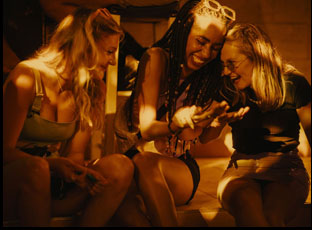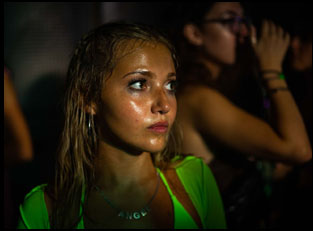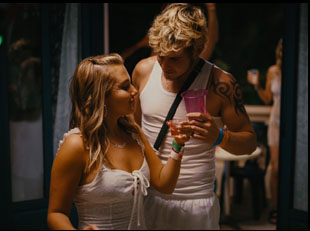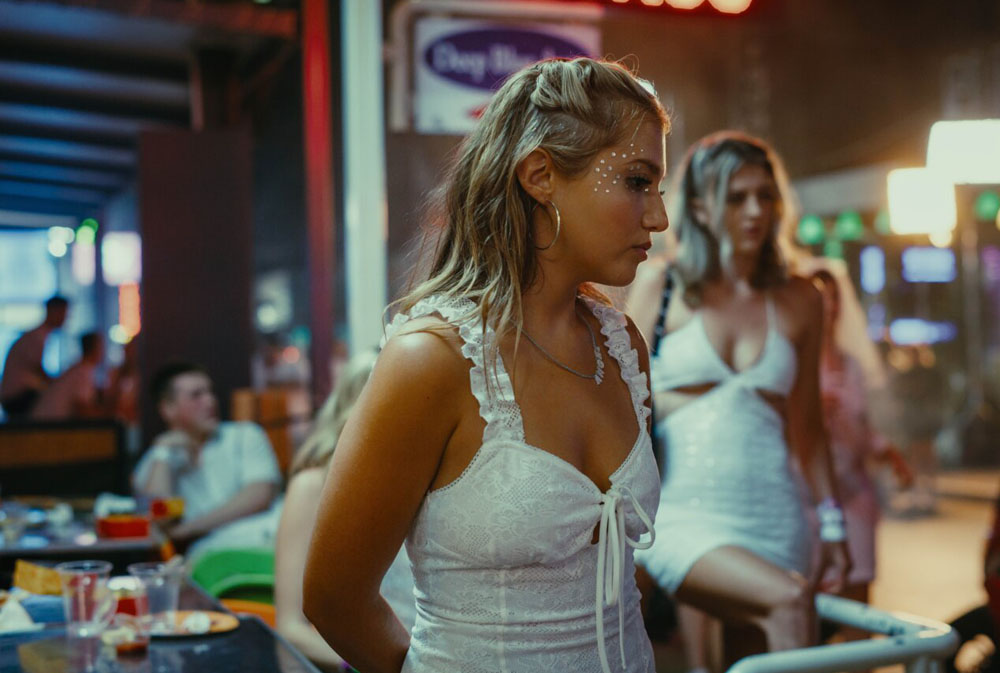In retrospect, it might’ve been fitting that on the second day of filming “How to Have Sex,” everybody looked like they were having fun but those at the center of the action were hardly enjoying themselves. Residents of the quiet town of Malia on the Greek island of Crete may have already been used to the annual influx of spring break revelers that comes to overwhelm the community, but while director Molly Manning Walker had the wherewithal to do crowd control, restaging what she had witnessed on her own during the height of tourist season with a boatload of extras, she was shooting massive pool scenes in the bitter cold of November and to achieve the feeling of madness that surrounds the film’s heroine Tara (Mia McKenna-Bruce), there had to be a similar level of level of craziness to the actual experience.
“It was super chaotic and quite hard to manage,” recalled Manning Walker, for whom the fact there was all these people in front of her writhing around silently in order to preserve the proper sound for the picture had to contribute to the surreality that ultimately made it up onto the screen. “Like [the] second day directing 250 extras and we had to get them dancing to no music and keep them energized. We definitely had a baptism of fire — the first two weeks were really full-on and then sort of after that we were shooting in the hotel, which felt like a bit of a walk in the park [by comparison].”
One wouldn’t be able to tell now, given how gracefully Walker is able to navigate calamity, both in locating Tara amongst the throngs of raucous party animals or in envisioning an even more arduous journey for the young woman, who is obliged by friends Skye (Lara Peake) and Em (Enva Lewis) to have a good time in Greece, but the pressure to have fun increasingly appears as depriving her of any sense of agency. All smiles upon entering the flat with her friends where Em declares, “Whoever’s getting laid the most should get the main room,” Tara gradually becomes disenchanted in the purported paradise as she’s ogled by Badger (Shaun Thomas) and Paddy (Samuel Bottomley), a pair of fellow Brits abroad whose room sits across from theirs on the strip and rather than feeling freedom when gigantic blue drinks arrive at her table or dancing in clubs, she only experiences discomfort, eventually having to borrow a skimpy dress from Skye that’s as ill-fitting as she looks in a place where you come to suspect she’s less alone than she feels.
Manning Walker, who came up as a cinematographer and lensed Charlotte Regan’s endearing comedy “Scrapper” in the midst of prepping “How to Have Sex,” shows an extraordinary sensitivity to the situation Tara finds herself in, unable to express what she’s feeling lest she look like a prude in front of her friends then trapped once the worst happens to suffer in silence as the party goes on without end. However, the director shows what a formative moment it is when Tara may feel as though there’s no way out, stranded in a foreign country, but can start to see how much she can trust her instincts when left to make choices for herself and the film may limit itself to a single event in her life, but it’s as likely to make an impression on audiences when so vividly evoked as it is to live in the back of her head for the rest of her days. After winning the Camera d’Or at last year’s Cannes Film Festival, the arresting drama is making its way to theaters this week after recent stops at Cannes and Toronto and Manning Walker kindly took the time to talk about how she created such a sensational debut in all respects of the term, seeking out authenticity wherever she could find it and how to balance out spontaneity and intricate planning.

It was mostly about how the fact that the conversation around consent hasn’t moved on and that teenagers were still talking about it in quite a horrific way, to be honest. So we took a lot of language, but also mannerisms, what music they were into and it informed it in quite a large way.
What was it like to find your wonderful cast for this? And did they change your ideas of what the characters could be?
It took a long time. When you’re casting an ensemble of six, it’s always a bit of a jigsaw puzzle like this person needs to now do this and this and this, so it was about testing them all together. That was a really extensive process, but super worthwhile and we could feel the electricity as soon as we brought them all together. Throughout the whole process, we were changing things up and responding to how they were responding to the piece. It was very reactive and often we would do something in rehearsal and I’d write the script or we’d see someone walking down the strip saying something and I would write it in, so it was this constant evolving thing.
I’ve heard you spent time in Malia before shooting. Was Greece immediately in mind as a setting?
We thought we were going to shoot in Spain, but then we were looking at Mediterranean holiday resorts and we started scouting in Greece. It just felt like the perfect backdrop. I spent some time there in the height of the [tourist] season and that was really inspirational because I could see how it was reacting live. I felt good about replicating it and the costume designer [George Buxton] came out also taking photographs of what people were really wearing.

Yeah, I guess it’s an iconic look these days. The idea was that she borrows Skye’s dress, so she feels the pressure of Skye on her when Skye’s not around and it was something that me and the costume designer came up with during the prep process. But every scene has a very strong color palette that’s quite strict within the film. The colors are all [associated with] something so green is Skye’s color, safety is represented within purples and the blues. Badger wears blue and then Paddy wears orange. That’s the danger color. And then it was reflected through the lighting as well and into the production design. The best bit about the filmmaking process was that all departments were very heavily collaborating together.
It seems like a really special bond you forged with your cinematographer Nicolas Canniccioni, who I understand largely shot docs before this. When it feels so alive and you’ve got those huge crowd scenes, how much can be planned out versus what’s intuitively captured on the day?
I storyboarded the whole film by hand, not necessarily to look at all the time, but it was amazing to have a backup plan and something up our sleeves. The way that I work, I really prep and then I don’t really look at it and the way that [Nicolas] preps is that he’s very responsive to what’s happening live in front of him, so it was quite a good collaboration in that way.
You do some really brilliant things with the soundtrack and the sound design in the film to convey Tara’s experience. What was it like to build the soundscape for this?
It was always tied quite heavily to [Tara’s] experience and the sound designer [Steve Fanagan] is an amazing guy who’s very emotionally connected and he has the capability to read the scenes very well and understand where it should dip emotionally. He did really smart things with slowly making the crickets get faster in the background, so you’re feeling more anxious, but you don’t know why or the bass gets deeper. Then the composer [James Jacob] is an amazing friend of mine who has been a DJ and is a music producer, but never composed a feature film before, so this was his first composing job. He’s super reactive to humans, and we definitely refined as we went on but the idea was that the bass represented the assault and you get retraumatized by it as you go through the film, so there were little moments like that.

It’s amazing. I had hoped that women would feel seen, but we didn’t really realize on what scale and that’s been really both upsetting and also quite empowering.
It also must be something to be quite proud of, having your first feature as a director under your belt. Has it been meaningful in that respect?
Yeah, it’s great. I mean, I think I’ll change careers now.
Keep it a perfect record, huh?
I think we’ve completed it. I think I want to be a radio presenter.
“How to Have Sex” opens on February 2nd in New York at the IFC Center and the Alamo Drafthouse Brooklyn, Los Angeles at the Alamo Drafthouse Downtown and in Austin at the Alamo Drafthouse South Lamar. It expands on February 9th across the country. A full list of theaters and dates is here.




